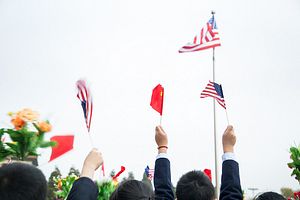By Hunter Marston
 There’s been a steady drumbeat building concerning the arrival of a new U.S.-China cold war. This narrative ignores today’s more diffuse balance of power, plays into the hands of those advocating a more confrontational approach to China, and reflects U.S. insecurity instead of confidence. The story we tell matters because it lays the foundation for competent strategy.
There’s been a steady drumbeat building concerning the arrival of a new U.S.-China cold war. This narrative ignores today’s more diffuse balance of power, plays into the hands of those advocating a more confrontational approach to China, and reflects U.S. insecurity instead of confidence. The story we tell matters because it lays the foundation for competent strategy.
Today’s headlines echo a steady stream of commentary from the Chinese Communist Party accusing the United States of harboring “a cold war mindset.” The tunnel vision inherent in this debate is dangerous because it locks analysts as well as practitioners into narrow and overly deterministic view of the Sino-American relationship. Like the “Thucydides trap” metaphor popularized by Graham Allison in his book by that title, it encourages unnecessary fatalism and determinism, and it serves the political purposes of war hawks.
This frame is overly narrow and inaccurate for several reasons, as I’ve explained elsewhere. For one, the world isn’t as bipolar as we may imagine. Take Southeast Asia for example, the locus of the most acute U.S.-China competition. Washington is seeing its long-held influence as the region’s security provider (it has alliances with the Philippines and Thailand) challenged by an increasingly powerful Beijing. China is the region’s largest trading partner, and it has increased its security cooperation with the regional Association of Southeast Asian Nations (ASEAN). But Southeast Asia remains remarkably multipolar.
To be sure, the polarization between Washington and Beijing may be more dramatic than the actual polarity of the international system. In the Indo-Pacific aspiring great powers like Japan and India also vie for influence. Both countries have deepened their security cooperation with Southeast Asian countries in order to boost maritime defense capacity in the South China Sea. Tokyo has provided coast guard patrol vessels to the Philippines and Vietnam. Japan has also retained influence as the region’s largest provider of development assistance for multiple decades. India for its part has enhanced interoperability with ASEAN counterparts and regularized joint naval and coast guard training drills such as the Singapore-India Maritime Bilateral Exercise (SIMBEX).
Second, contrary to the Cold War, when the two hegemons divided the world into competing blocs, small states have a great deal of agency to affect today’s balance of power and manage their external security environments. By and large, Southeast Asian countries are not neatly dividing into blocs along pro-China or pro-U.S. lines. Instead, they are hedging and pursuing diversified foreign relations in order to reduce reliance on any one great power. They also strive to keep both Beijing and Washington engaged by playing the two competing powers off of one another.
Finally, the rules of the game have changed since the Cold War. The world has seen fewer military coups supported or directly orchestrated by the great powers. Rather, as suggested above, the United States and China now compete for influence in the open, and loyalties are fluid. A couple examples may be useful. In Venezuela, a hotbed of anti-American leftism, the United States has failed to bring about peaceful (or violent) political change to see its preferred leader, Juan Guaido, wrest political power from the regime of Nicolas Maduro. In Pakistan, a critical U.S. partner during the Cold War as well as the global war on terror and U.S. war in Afghanistan, Beijing has built steady inroads — literally laying the country’s physical infrastructure via the China-Pakistan Economic Corridor. In 2018, the two sides pledged to strengthen the “all-weather strategic cooperative partnership.” Yet there are concerns regarding potential backlash in response to over-exposure to Chinese debt and, and Prime Minister Imran Khan has struggled to balance relations with the west.
The mental frames we use to describe bipolar competition matter. The narrative battle will shape public opinion surrounding what is now the most consequential bilateral relationship in the 21st century. So far, polls have shown that the American people have not yet bought into the characterization of China as an enemy, though perceptions are shifting.
The trend toward depicting China as the enemy is no doubt facilitated by the Trump administration’s racist characterization of the novel coronavirus as a “Chinese virus” and assertions that it came from a lab in Wuhan. If President Trump’s narrative ploy succeeds in convincing ordinary Americans that China is inimical to U.S. security, it will make a U.S.-China hot war more conceivable. Ominously, it appears that Trump’s Democratic rival for the 2020 presidential election, former Vice President Joe Biden, may be taking the bait and trying to out-hawk the president on China.
As analysts, we need to be careful about the language and mental frames we use to describe the relationship. It is true that China is the United States’ chief competitor. However, that does not predetermine that the outcome of this rivalry is conflict.
The media also has an important role to play in shaping popular perceptions, and it should refrain from overly simplistic or convenient tropes that mirror those of the Chinese Communist Party.
A smart strategy to compete with China should be premised not on xenophobic and reactionary impulses but on confidence in the American model to triumph and appeal to international partners in cooperative efforts to check China’s worst instincts for power projection. That begins by getting our story straight and crafting a more compelling narrative at home. While alluring, the “new Cold War” polemic is the wrong frame for a winning strategy.
Hunter Marston (@hmarston4) is a Ph.D. candidate at the Australian National University and independent consultant with GlobalWonks, LLC.
No comments:
Post a Comment